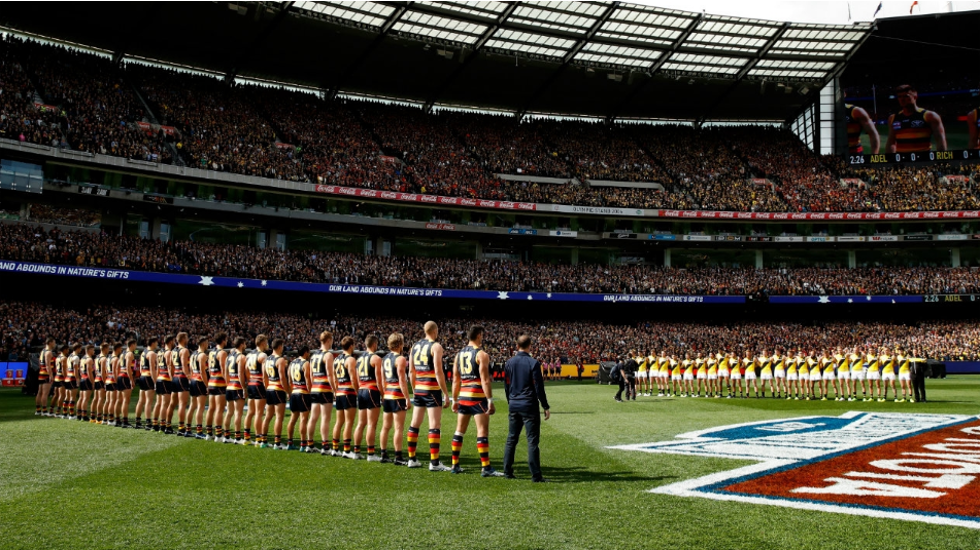No doubt about the romance of Richmond’s grand final win last year. But how does the actual quality of football stack up these days? Photo: AFL MEDIA
AFL competition that’s better than ever – but is the game?
Uncertainty is a word AFL football’s administrators don’t mind hearing on the eve of a new season, at least when it comes to the business of on-field prognostication.
Anyone who has attempted to put together a ladder for 2018 will know exactly what we’re talking about. Because surely in football history premierships have never been more up for grabs than they are right now.
The last two flags have been fairytales. Richmond last year won a first premiership for 37 years after having finished the previous season 13th on the ladder. The Western Bulldogs in 2016 won their first for 62 years and their second ever two years after having finished 14th.
The gap between best and worst has never been narrower. Last year’s ladder leader, Adelaide, accumulated less points than any top team since 1997. Wooden spooner Brisbane had more than any bottom side since 1998.
Basically, any team these days is a chance of at least a finals spot with a little luck and a decent run with injuries. And the element of hope is what keeps fans coming through the turnstiles, turning on their TVs, and buying memberships in ever-increasing numbers.
Uncertainty, though, is also a word which can be applied to the direction of the game they’re now watching, on a number of levels. And perhaps that isn’t necessarily such a good thing.
Romantic storylines and greater optimism about our teams aside, what about the actual product itself? Is the quality what it was 30, 20, even 10 years ago? Are what were historically the most fundamental elements of the game as integral as they used to be?
Are the most reliable indicators of success now qualities which help define Australian football’s uniqueness, or borrowings from other sports which have only helped homogenise our product?
I’m not firmly wedded to one or other answer to any of those questions. I’ve also been a big believer in the natural evolution of the game and the capacity of inventive coaching to continue to shift how the game is played.
But I do worry there are aspects of football of which we’re not seeing enough, and others less desirable we’re finding it harder to budge. And about what the consequences of that are to the longer-term spectacle.
Big marks and goals were once a given in our game, and probably the major selling point. Do we see enough of either now? I’d argue not. The “screamer” is a rarity these days (perhaps with the exception of the miraculous Jeremy Howe).
And scoring certainly ain’t what it used to be. The last four AFL seasons have been the lowest-scoring football has seen since 1970. You don’t even have to go that far back for a stark contrast.
The 1993 season, 25 years ago this year, is universally acclaimed as one out of the box. It certainly wasn’t short of goals.
On average, all teams were scoring about three goals per game more than they did last year. Tony Modra, Jason Dunstall and Gary Ablett senior all finished that season with goal tallies of 120-plus.
Last year, Lance Franklin won the Coleman Medal with a tally of just 69. Franklin remains the only man to reach the 100-goal mark in the past 13 seasons. Indeed, it’s more likely than not he’s the last we’ll ever see.
Congestion, that scourge of the modern game, remains the obvious answer to the scoring shortfall, but solutions to that issue thus far have been in short supply.
The rule makers have dabbled at the edges, focussing most heavily on interchange numbers and the hope that greater fatigue will open games up and make finding the pathway to goal easier.
By 2013, average interchange numbers per team had skyrocketed to 133. A cap of 120 curbed that only minimally, ditto the 90 to which the cap was subsequently reduced and has been in operation the past two seasons.
Some insist more radical slashing of that limit will do the trick. But 133 to 90 is at least a cut of one-third. And the average points per team in 2013 of 92 was the last time that number was higher than 80-something. I’m not convinced the logic about reduced interchange stacks up.
And speaking of stacking up, it’s forward pressure which has replaced marks and goals as AFL football’s new black.
Getting the ball forward and locking it in forward lines with intense physical pressure has been the modus operandi for both the Bulldogs and Richmond’s premiership wins of the past two years.
It’s football as a swarm. How aesthetically pleasing is it compared to watching a team transfer the ball from end to end with quick movement and precise skills? I’ve got my reservations.
The hope in our game is always that tactical evolution will continue to find new ways of beating the status quo. It’s the fear that the current mechanisms are so efficient and effective that they can’t be surpassed which is the fear.
Heading into a new AFL season, there’s absolutely no doubt the competition is tighter than ever. That’s great. But as we prepare for 2018, we must also ask whether, fundamentally, the game itself is as good. Me? I’m uncertain.
*This article first appeared on SPORTING NEWS. Check it out for all the latest news and views on your favourite sport.












I’d ask anyone reading this to actually sit down and watch a game from 1993, I guarantee you’d be surprised. Sure there were more goals, but tackling was barely executed and the games look like they’re played in slow motion. Skills are undoubtedly far better now than in the 1990s.
Stop romantising the past, “footy was better back in the day” is some pretty lazy journalism.
Absolutely entitled to your view HDT, but I think it’s a stretch to say tackling was barely executed in 1993, or that they were “slow motion”. I defy anyone to watch even two minutes of, say, the 1994 preliminary final between Geelong and North Melbourne and argue that is slow! Also, this was an opinion piece, one I’d argue strongly was supported with plenty of evidence, and which actually asked a question rather than came down strongly on one side of the argument or the other. That IS journalism. A pat conclusion that I’ve merely said “footy was better back in the day” and use of the cliched “lazy journalism” jibe is a far lazier effort in my view!
With Bulldogs then Tigers winning flags, it is amazing what happens when cheating is stopped. Quality of players will always improve as skills improve under pressure. The more pressure the better the contest.
In 1993, there were 300 blokes on the field on any given weekend (15 teams x 20 players each, plus one pig at the SCG). Now we have 396 (18 teams x 22 players each). That’s a big increase. While it’s unarguable that footballers have never been fitter, it’s widely accepted that the general standard of footballer skills is at best no better than the 1990s, despite the increased professionalism of clubs. We still get amazing skills from the top players, but overall? Well, a quarter of the blokes who will run out in Round 1 this year wouldn’t have gotten a game in 1993, so the average must be down. Meanwhile, the players’ fitness has never made a football ground seem smaller; they fill spaces they couldn’t before. So the game’s highlight reel is reduced, because too few players have the space or skills to pull off great marks and great goals. The answer? Well, maybe the VFA was onto something a few decades ago. Pull back to 16 a side, with three on the pine. That takes more than 50 of our least capable players out of the system, and frees up space for the talented ones to actually display their skills. Forget about Americanisations such as zones or artificially capped rotations; just make sure we’ve got the best players we can, and give them the best conditions possible to ply their trades.
Lethal’s Lions were the lastofnthe classic football teams. As much as I enjoyed the ’05 GF, it marked a profound change and the game has never been quite as good since. One day we’ll be sitting on the verandah of a retirement home saying “Fraser Gehrig, remember him? Last of the old fashioned full forwards, that bloke.”
We need to wire up the players to a crowd controlled machine that recognises mass boredom. When the threshold is reached, 6 players from each side are zapped into a state of temporary paralysis.
FINALLY ….. someone mentions the last great season of football of 1993 (with the possible exception of 2008 where the top 3 teams were all relatively high scoring outfits). I was immediately aware that the game changed in 1994. But I thought it was an aberration. 25 years later the aberration has become the standard.
Centre clearance, F50 stoppage, repeat F50 stoppage, repeat F50 stoppage, repeat F50 stoppage, repeat F50 stoppage, quick kick out of stoppage, ball wobbles through for a lucky goal. Back to centre. Centre clearance, F 50 stoppage…